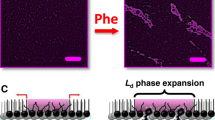Summary
Phosphatidyl ethanolamine (PE) is shown to be effective in producing membrane aggregation. The aggregation of PE and PE/PC (phosphatidyl choline) mixed vesicles was studied as a function of pH and cation composition of the medium. The kinetics and equilibria were studied in stopped-flow rapid mixing experiments, in which PE vesicles prepared at pH 9.2 were “jumped” to pH 7.
H+ ions protonate PE− and promote vesicle aggregation in a cooperative fashion. Vesicles containing PC have a decreased tendency to aggregate compared to pure PE vesicles. The apparent rate constant for aggregation was about two orders of magnitude below that for diffusion controlled aggregation and was virtually the same for PE and PE/PC mixed vesicles.
A theoretical description of equilibrium for vesicle aggregation is developed in terms of three parameters: the equilibrium constant for the protonation of PE (K A ), the equilibrium constant for aggregation (K eq) and the number of PE molecules in an effective area that the two vesicles must interact in order to aggregate (N eff). These parameters are compared with values and trends expected for electrostatic calculations based on dipolar repulsion and short-range binding, to which hydrogen bonding may contribute. The results are interpreted in a self-consistent fashion to indicate: (i) that PE and PC mix randomly, (ii) that head-to-tail binding occurs between PE(PC) molecules on apposing vesicles, (iii) that electrostatic screening accounts for the decrease inK A as a function of the molar fraction of PC per vesicle, (iv) that the PE must be 90% protonated before aggregation can occur, and (v) that for all the lipid systems we considered, the point at which the extent of dimerization is half maximal is close to the physiological pH, indicating that PE may have a regulatory effect in the aggregation of biological systems.
Similar content being viewed by others
References
Blume, A., Ackerman, T. 1974. A calorimetric study of the lipid phase transitions in aqueous dispersions of phosphorylcholine-phosphorylethanolamine mixtures.FEBS Lett. 43:71
Colbow, K., Jones, B.L. 1974. On the stability of the liquid-crystalline lamellar lecithin-water system.Biochim. Biophys. Acta 345:91
Dean, P.M., Matthews, E.K. 1975. The London van der Waals attraction constant of secretory granules and its significance.J. Theor. Biol. 54:309
Fuller, N., Rand, R.P., Parsegian, V.A. 1979. Measured work of deformation and repulsion of lecithin bilayers.Proc. Nat. Acad. Sci. (in press)
Hauser, H., Phillips, M.C. 1973. Structures of aqueous dispersions of phosphatidylserine.J. Biol. Chem. 248:8585
Haynes, D.H. 1974. 1-Anilino-8-naphthalenesulfonate: A fluorescent indicator of ion binding and electrostatic potential on the membrane surface.J. Membrane Biol. 17:341
Haynes, D.H., Simkowitz, P. 1977. 1-Anilino-8-naphthalenesulfonate: A fluorescent probe of ion and ionophore transport kinetics and trans-membrane asymmetry.J. Membrane Biol. 33:63
Haynes, D.H., Staerk, H. 1974. 1-Anilino-8-naphthalenesulfonate: A fluorescent probe of membrane surface structure, composition and mobility.J. Membrane Biol. 17:313
Hitchcock, P.B., Mason, R., Thomas, K.M., Shipley, G.C. 1974. Structural chemistry of 1,2 dilauroyl-dl-phosphatidylethanolamine: Molecular conformation and intermolecular packing of phospholipids.Proc. Nat. Acad. Sci. USA 71:3036
Lansman, J., Haynes, D.H. 1975. Kinetics of a Ca2+-triggered membrane reaction of phospholipid membranes.Biochim. Biophys. Acta 394:335
LeNeveu, D.M., Rand, R.P., Parsegian, V.A. 1976. Measurement of forces between lecithin bilayers.Nature (London) 259:601
LeNeveu, D.M., Rand, R.P., Parsegian, V.A., Gingell, D. 1977. Measurement and modification of forces between lecithin bilayers.Biophys. J. 18:209
Llinas, R.R., Heuser, J.E., editors. 1977. Depolarization-Release Coupling Systems in Neurons.Neurosci. Res. Program Bull. Vol. 15
MacDonald, R.C., Simon, S.A., Baer, E. 1976. Ionic influences on the phase transition of dipalmitoylphosphatidylserine.Biochemistry 15:885
McAlister, M., Fuller, N., Rand, R.P., Parsegian, V.A. 1978. Measurement of surface pressure in and repulsion between approaching phospholipid membranes.Biophys. J. 21:213a
Monod, J., Jeffries, W., Changeux, J.-P. 1965. On the nature of allosteric transitions: A plausible model.J. Mol. Biol. 12:88
Morris, S.J., Chiu, V.C.K., Haynes, D.H. 1979. Divalent cation-induced aggregation of chromaffin granule membranes.Membrane Biochem. (in press)
Nir, S. 1976. Van der Waals interactions between surfaces of biological interest.Prog. Surf. Sci. 8:1
Papahadjopoulos, D. 1968. Surface properties of acidic phospholipids: Interaction of monolayers and hydrated liquid crystals with uni- and bi-valent metal ions.Biochim. Biophys. Acta 163:240
Papahadjopoulos, D., Poste, G., Schaeffer, B.E., Vail, W.J. 1974. Membrane fusion and molecular segregation in phospholipid vesicles.Biochim. Biophys. Acta 352:10
Papahadjopoulos, D., Vail, W.J., Pangborn, W.A., Poste, G. 1976. Studies of membrane fusion: II. Induction of fusion in pure phospholipid membranes by calcium ions and other divalent metals.Biochim. Biophys. Acta 448:265
Parsegian, V.A., Gingell, D. 1972. Some features of physical forces between biological cell membranes.J. Adhes. 4:283
Small, D.M. 1967. Phase equilibria and structure of dry and hydrated egg lecithin.J. Lipid Res. 8:551
Smoluchowski, M. 1916. Drei Vorträge über Diffusion, Brownsche Molekularbewegung und Koagulation von Kolloidteilchen.Phys. Z. 17:557
Stollery, J.G., Vail, W.J. 1977. Interactions of divalent cations or basic proteins with phosphatidylethanolamine vesicles.Biochim. Biophys. Acta 471:372
Verwey, E.J.W., Overbeek, T.Th.G. 1948. Theory of Stability of Lyophobic Colloids. Elsevier, Amsterdam
Wilkinson, D.A., Morowitz, H.J., Prestegard, J.H. 1977. Hydration of phosphatidylcholine.Biophys. J. 20:169
Yeagle, P.L., Hutton, W.C., Huang, C.-H., Martin, R.B. 1976. Structure in the polar head region of phospholipid bilayers: A31P{1H} nuclear Overhauser effect study.Biochemistry 15:2121
Author information
Authors and Affiliations
Rights and permissions
About this article
Cite this article
Kolber, M.A., Haynes, D.H. Evidence for a role of phosphatidyl ethanolamine as a modulator of membrane-membrane contact. J. Membrain Biol. 48, 95–114 (1979). https://doi.org/10.1007/BF01869258
Received:
Revised:
Issue Date:
DOI: https://doi.org/10.1007/BF01869258




